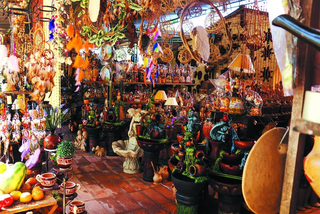
Goldsmiths, University of London, legally the Goldsmiths' College, is a constituent research university of the University of London in England. It was originally founded in 1891 as The Goldsmiths' Technical and Recreative Institute by the Worshipful Company of Goldsmiths in New Cross, London. It was renamed Goldsmiths' College after being acquired by the University of London in 1904, and specialises in the arts, design, computing, humanities and social sciences. The main building on campus, known as the Richard Hoggart Building, was originally opened in 1792 and is the site of the former Royal Naval School.

Cultural tourism is a type of tourism activity in which the visitor's essential motivation is to learn, discover, experience and consume the tangible and intangible cultural attractions/products in a tourism destination. These attractions/products relate to a set of distinctive material, intellectual, spiritual, and emotional features of a society that encompasses arts and architecture, historical and cultural heritage, culinary heritage, literature, music, creative industries and the living cultures with their lifestyles, value systems, beliefs and traditions.
The creative industries refers to a range of economic activities which are concerned with the generation or exploitation of knowledge and information. They may variously also be referred to as the cultural industries or the creative economy, and most recently they have been denominated as the Orange Economy in Latin America and the Caribbean.

Shunde is a district of the city of Foshan, Guangdong province, located in the Pearl River Delta. It had a population of 2,464,784 as of the 2010 census. Once a traditional agricultural county, it has become one of the most affluent counties in Guangdong and mainland China. Since 2009 it has been administered independently of Foshan city, answerable directly to the Guangdong provincial government.

Areguá is a creative city and the capital of Central Department in Paraguay. It is known for its production of strawberry products, pottery, colonial architecture and historic cobblestone streets.

The University for the Creative Arts is a specialist art and design university in the south of England.

Creative Australia, formerly known as the Australia Council for the Arts and the Australia Council, is the country's official arts council, serving as an arts funding and advisory body for the Government of Australia.

Indira Gandhi National Centre for the Arts (IGNCA), New Delhi is a premier government-funded arts organization in India. It is an autonomous institute under the Union Ministry of Culture.

The culture of West Bengal is an Indian culture which has its roots in Bengali literature, music, fine arts, drama and cinema. Different geographic regions of West Bengal have subtle as well as more pronounced variations between each other, with Darjeeling Himalayan hill region and Duars showing particularly different socio-cultural aspects.
The Arts in the Philippines are all the arts in the Philippines, from the beginning of civilization to the present. They reflect a range of artistic influences on the country's culture, including indigenous art. Philippine art consists of two branches: traditional and non-traditional art. Each branch is divided into categories and subcategories.
The creative city is a concept that argues creativity should be considered a strategic factor in urban development. In addition to cities being efficient and fair, a creative city provides places, experiences, favorites, attractions, and opportunities to foster creativity among its citizens.

UNESCO's City of Literature programme is part of the wider Creative Cities Network.

UNESCO's City of Film project is part of the wider Creative Cities Network.

The arts are a very wide range of human practices of creative expression, storytelling, and cultural participation. They encompass multiple diverse and plural modes of thinking, doing, and being, in an extremely broad range of media. Both highly dynamic and a characteristically constant feature of human life, they have developed into innovative, stylized, and sometimes intricate forms. This is often achieved through sustained and deliberate study, training, and/or theorizing within a particular tradition, across generations, and even between civilizations. The arts are a vehicle through which human beings cultivate distinct social, cultural, and individual identities while transmitting values, impressions, judgements, ideas, visions, spiritual meanings, patterns of life, and experiences across time and space.

The UNESCO Creative Cities Network (UCCN) is a flagship city programme of UNESCO launched in 2004 to promote cooperation among cities which have recognized culture and creativity as strategic drivers of sustainable urban development. As of 2022, there are almost 300 cities from around 90 countries in the network.

UNESCO's City of Music programme is part of the wider Creative Cities Network.
UNESCO's Design Cities project is part of the wider Creative Cities Network. The Network launched in 2004, and has member cities in seven creative fields. The other fields are: Crafts and Folk Art, Music, Film, Gastronomy, Literature, and Media Arts.

UNESCO's City of Gastronomy project is part of the wider Creative Cities Network. The Network was launched in 2004, and organizes member cities into seven creative fields: Crafts and Folk Art, Design, Film, Gastronomy, Literature, Media Arts, and Music.
UNESCO's City of Crafts and Folk Arts project is part of the wider Creative Cities Network, founded in 2004, which designates cities worldwide that have made unique contributions to the field of crafts and folk arts.
Saleem Beg is an Indian art conservator, historian and columnist. He is working to conserve / preserve the artworks, architecture, archaeology, besides museum collections mainly connected to Kashmir heritage. He prepared the research dossier of seven crafts include papier-mache, pashmina, Khatamband, Woodwork, Pinjrakari (latticework), Ari and Metal craft which placed the Srinagar city of Jammu and Kashmir in the list of UNESCO creative cities network for 2021, in the field of craft and folk art.













